Day 1 of a two day Spring Tour over the Easter weekend. With the weather forecast better for tomorrow, at least in theory, we opted to head up to the coast today and aim for the Brecks on Sunday. The weather forecast was not too bad for today either – showers, with the chance of heavier rain spreading in late on. Unfortunately, it turned out to be anything but – it started to rain at about 10.30am and continued for the rest of the day. Still, we made the most of it – and good use of several hides!
Our first destination for the morning was Holkham. We parked at the top of Lady Anne’s Drive and got out to see what we could spot out on the grazing marshes. There were a few Wigeon out here again today, as well as several Teal and a pair of Shoveler. In amongst them, we could see a few waders too – Curlew, Redshank and Oystercatchers.
There were a lot of gulls out on the grass the other side of the drive. They were predominantly Black-headed and Common Gulls but a quick scan with binoculars revealed there were quite a few Mediterranean Gulls as well. We got the scope on them for a closer look.
As we walked up towards the pines, we looked across to the hedgerow which runs along the north edge of the grazing marsh and noticed quite a few Blackbirds either down in the grass or up in the bushes above. There are a few which stay here for the summer, but these were presumably migrants, feeding up before flying back across to Scandinavia.
We took the track which heads west along the inland side of the pines. One of the first birds we heard was a Chiffchaff singing, a summer migrant which has probably only returned here in the last few days. Perhaps spring is not far away? A Goldcrest was initially flitting around up in the trees nearby but then flew across the path and landed in some low brambles right beside the path.
Salts Hole was fairly quiet today – just a pair of Tufted Ducks and a single Little Grebe at the back. But we heard a Treecreeper singing behind us and turned round to see it climbing up the trunk of a tall pine. A quick scan from the gate a little further on revealed several Jays, which dropped out of the trees and down onto the grassy bank, presumably looking for acorns which they had buried earlier. A pair of Grey Partridge were hiding in the grass nearby.
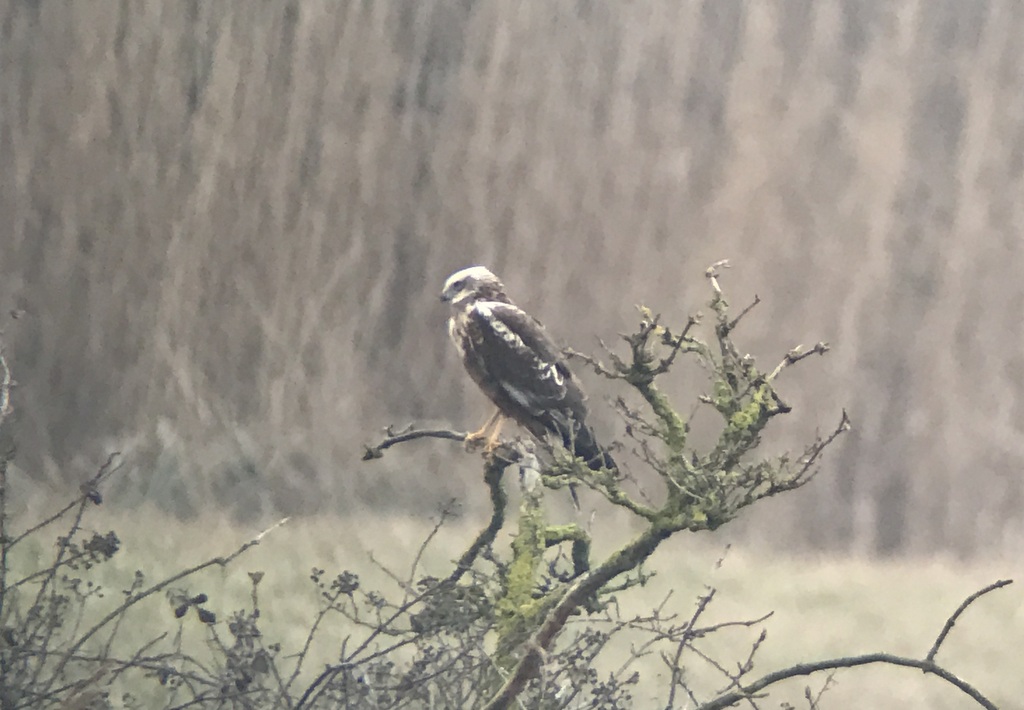
When we got into Washington Hide, the first thing we saw was a smart male Marsh Harrier perched in one of the bushes at the back of the reedbed. There was a female Marsh Harrier around too, which flew across to chase off one of last year’s juveniles. Otherwise, they weren’t doing much on a cold, grey morning. Further back, two Common Buzzards were perched together in a small tree. They looked strikingly different – one classically dark brown, the other strikingly pale. A Red Kite was a bit more active, and drifted high across the middle of the grazing marshes.
There weren’t many ducks on the pool in front of the hide today, just four Tufted Ducks and no sign now of the Common Pochard we had seen drop in here earlier, on our walk out. Scanning round the edge of the pools out in the middle of the grass, we found a pair of Pintail preening, the last pair to leave here. A lone Pink-footed Goose out on the grazing marshes too had an obviously damaged wing. It had most likely been shot and injured and is now unable to fly back to Iceland to breed.
A Great White Egret was very distant from here, and then flew across and dropped down out of view behind the sallows. We had a better view of it from further along the path, where we could get it in the scope as it stalked around in a reed-fringed ditch. Interestingly this bird had a largely black bill, rather than the more usual yellow. The bill colour of Great White Egrets darkens when they are in breeding condition.
As we were walking through the holm oaks towards Meals House, we heard a high pitched call above us and looked up to see a Firecrest. We had a great view of it as it flicked around in the leaves, we could see its more boldly marked head pattern compared to a Goldcrest, with black and white stripes on its face. We watched it for a couple of minutes before it flew back and disappeared into the trees behind.
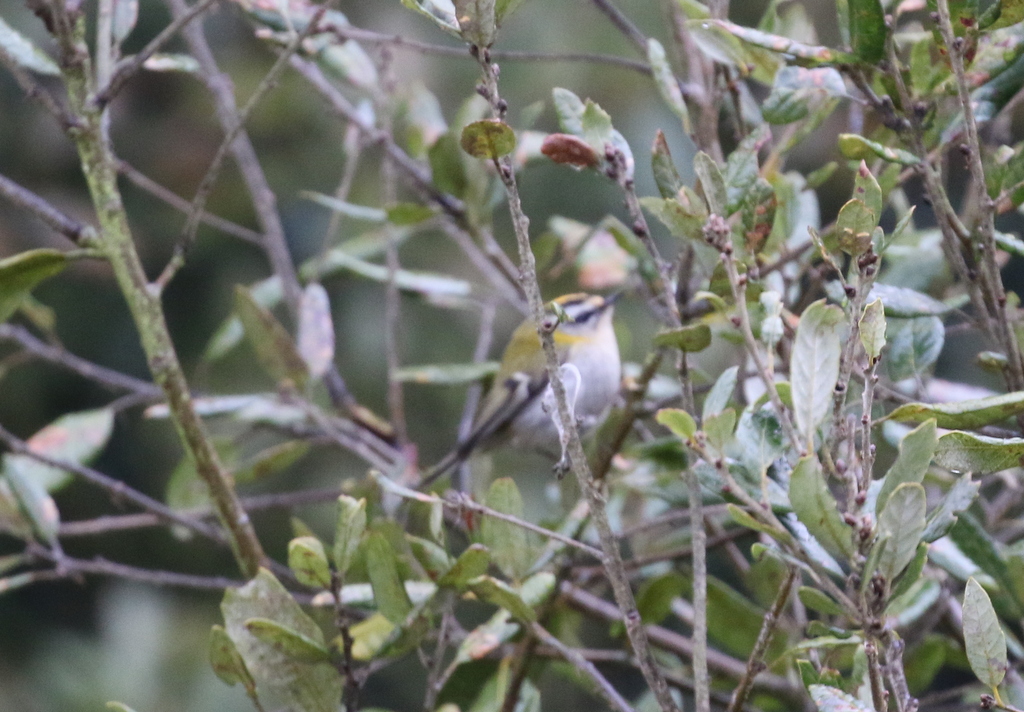
There were a few geese out on the grassy bank in front of Joe Jordan Hide. As well as all the usual Greylags and an Egyptian Goose, there were seven Pink-footed Geese. It was great to see the Greylags and Pinkfeet alongside each other for comparison – the latter noticeably smaller and darker, lacking the big orange carrot of a bill of the former.
Scanning through the rest of the geese carefully, we noticed a single White-fronted Goose, further back on the bank of the old fort. Through the scope, we could see the white surround to the base of its bill. It was lacking the black belly bars seen on adult White-fronted Geese, so it appeared it was a juvenile from last year. There were over 100 White-fronted Geese still here a week ago, but the rest have all left in the last few days, heading back to Russia for the breeding season. Why this one might have stayed behind was not immediately clear.
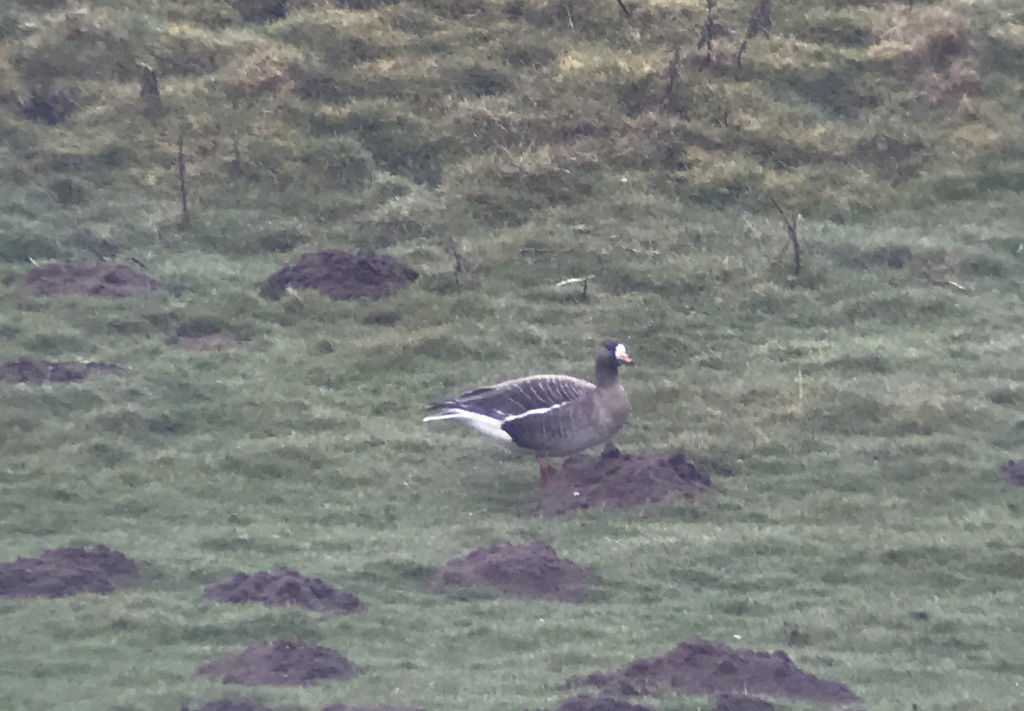
At this point, it started to rain. We assumed it would just be a shower, so we stayed in the hide. The Spoonbills were not doing much in the rain. We could see two tucked down in the trees, mostly hidden through the reeds behind the bank, doing what Spoonbills like to do best, asleep. While we watched, another Spoonbill would occasionally fly up out of the trees, circle round, and drop back in. One flew out and continued off towards Burnham Overy harbour.
One of the group spotted another Great White Egret, out in the wet grass away to the west of the hide. It was obviously different from the first one we had seen earlier, as it had a bright yellow bill. We could also still see the first, out on the edge of one of the pools to the east. After a while, this second Great White Egret flew up into the trees, but then came down and landed on the wet grass in front of the hide, where we got a great look at it.
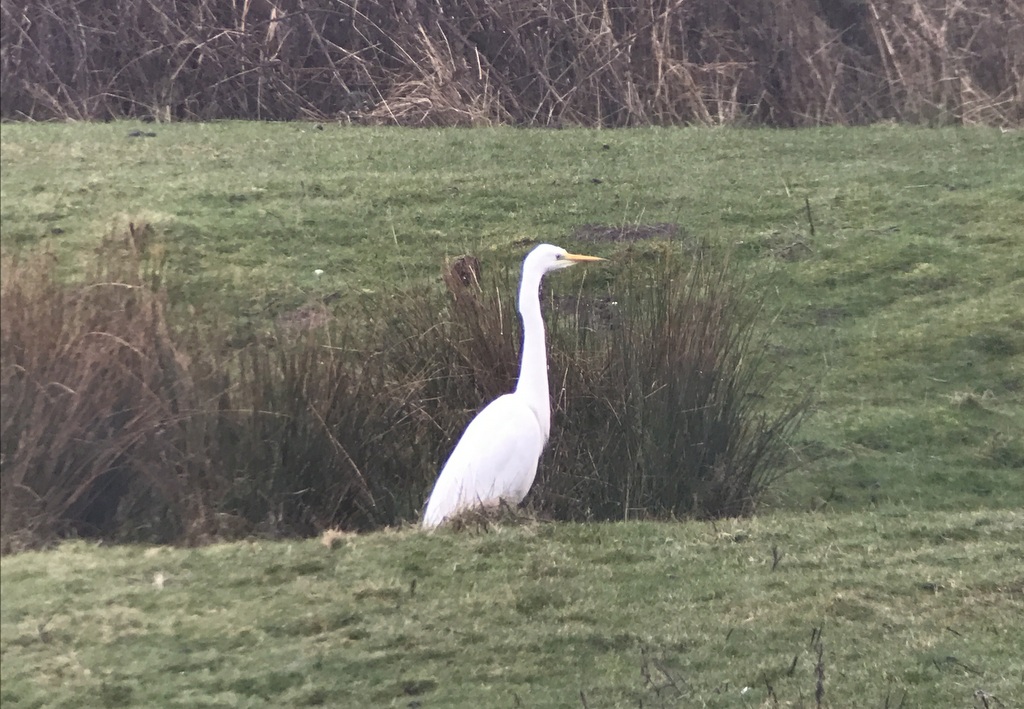
Then a third Great White Egret appeared, over towards the back. We could see them all at the same time, even though they were widely spaced out, in different parts of the marsh. This new bird was different again, with a very dirty yellow bill, presumably in the process of changing colour.
There was lots to see from the Joe Jordan Hide today, but we had really hoped to head out into the dunes from here to look for migrants this morning. We hung on for a bit to see if the rain would ease off but, after a discussion between the group, eventually decided we would head back to the car and avoid getting too wet!
We made our way over to Titchwell next. It was already lunchtime, so we ate our lunch before heading out onto the reserve. There were no Bramblings in the sallows on the way from the car park today, but we could hear one or two singing in the tops of the trees by the visitor centre. There was no sign of any at the feeders though, just Chaffinches, Goldfinches and a couple of Greenfinches.
After lunch, we made our way down the main path. There was very little on the Thornham ‘pool’ but while we were scanning we heard Bearded Tits calling behind us and turned to see a pair of them feeding in the reeds just below the path.
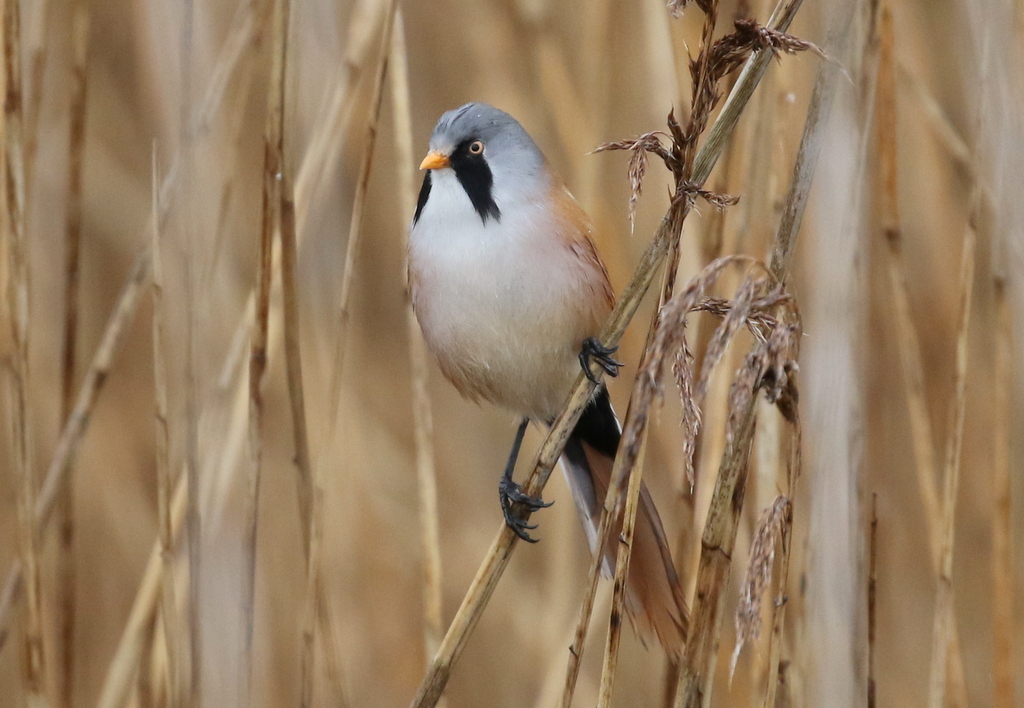
The Bearded Tits put on a great show again today, despite the rain. They have been performing very well for the crowds for the last ten days or so now, regardless of the weather, which is unusual, but great to see.
We watched as they two of them clambered through the base of the reeds, the male Bearded Tit with its powder blue head and black moustache and the browner female. The male stopped for a while in a small block of reeds and kept climbing up a stem up to the seedhead at the top before dropping back down again.
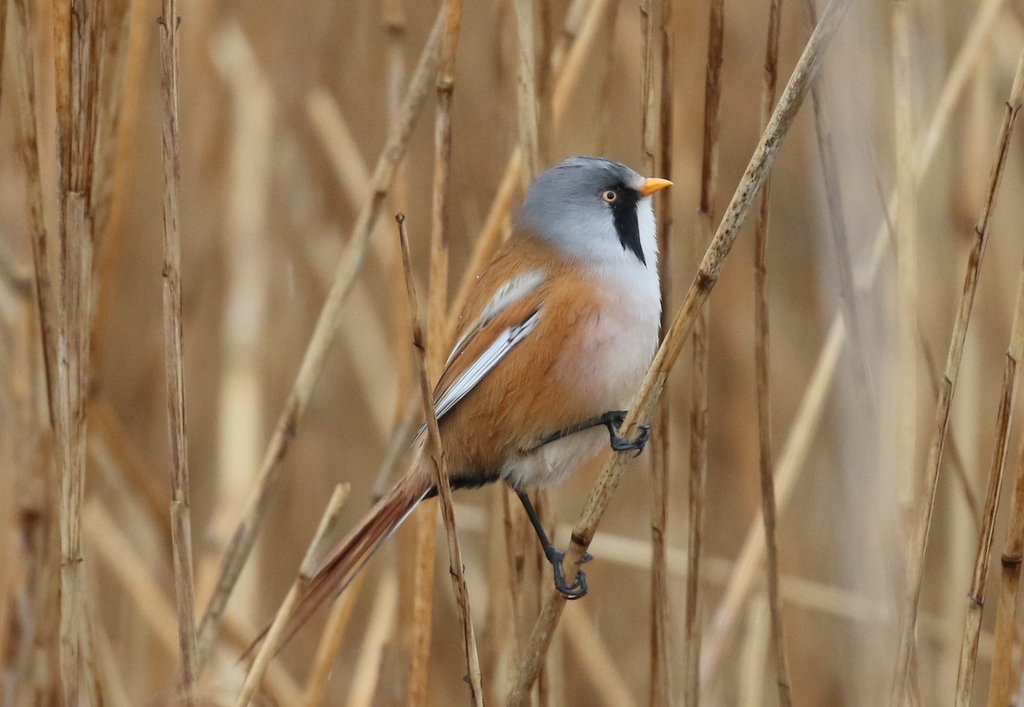

Eventually, we had to tear ourselves away and headed out towards the freshmarsh. There were more Bearded Tits further along too though, as we stopped to look at the reedbed pool. There were just a few Tufted Ducks and Common Pochard on here, as well as a single Little Grebe at the back. A pair of Mediterranean Gulls circled over the reeds, calling their very distinctive ‘keeoww’.
The water level on the freshmarsh has been very high for several months now and all the rain overnight and today had not helped at all either. The few small areas of mud suitable for waders had disappeared again. As a consequence, there were not many on here today.
After starting to rise in February and early March, Avocet numbers have dropped back down again, and there were only two on the freshmarsh today. It will be interesting to see how many decide to try to nest on the fenced off ‘Avocet Island’ this year, given it has been taken over by gulls again. Otherwise, there were just a few Oystercatchers on here today.
There was no sign of the Little Ringed Plovers at first, which had been on the muddy areas again yesterday. We did eventually see one fly past, but it went through too quickly for the rest of the group to get onto and didn’t land. They are obviously going somewhere else at the moment, given the lack of suitable habitat here. A single Ruff was feeding in amongst the gulls inside the fence.
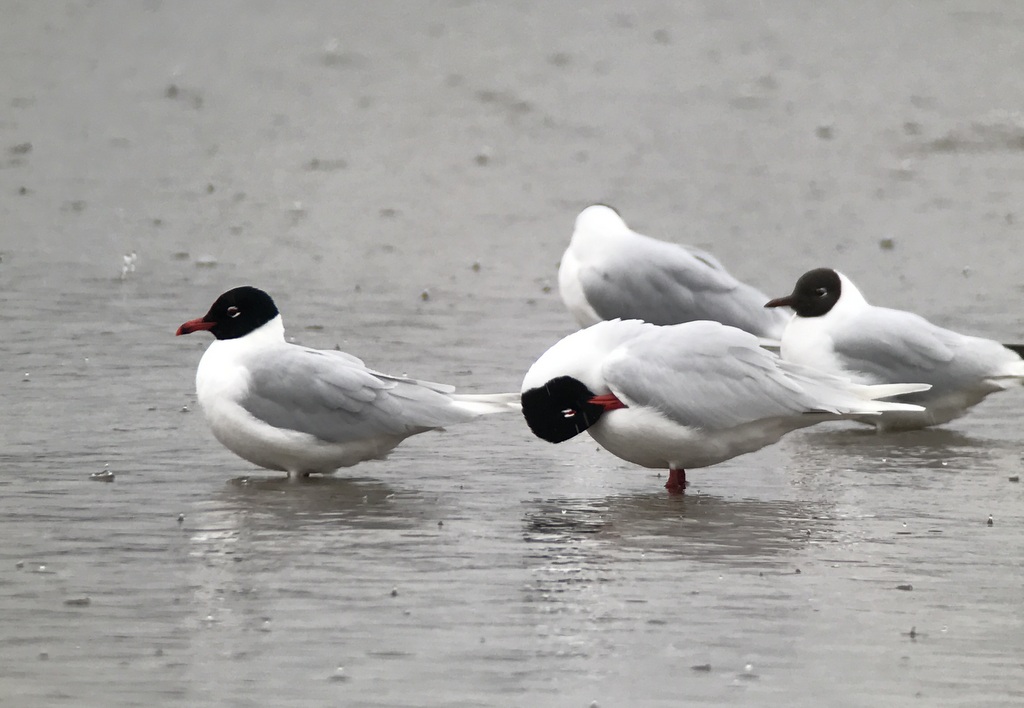
There are certainly plenty of gulls on the freshmarsh. The island has been taken over by lots of Black-headed Gulls and there are remarkable numbers of Medieterranean Gulls here too at the moment. It will be interesting to see how many pairs of the latter stay to breed this year.
The adult Mediterranean Gulls are looking stunning at the moment and we got a pair in the scope when they landed out in front of the hide, admiring their jet black hoods and white eyelids. There were also several Herring Gulls and Great Black-backed Gulls which dropped in to the water, and a single Lesser Black-backed Gull appeared with them too.
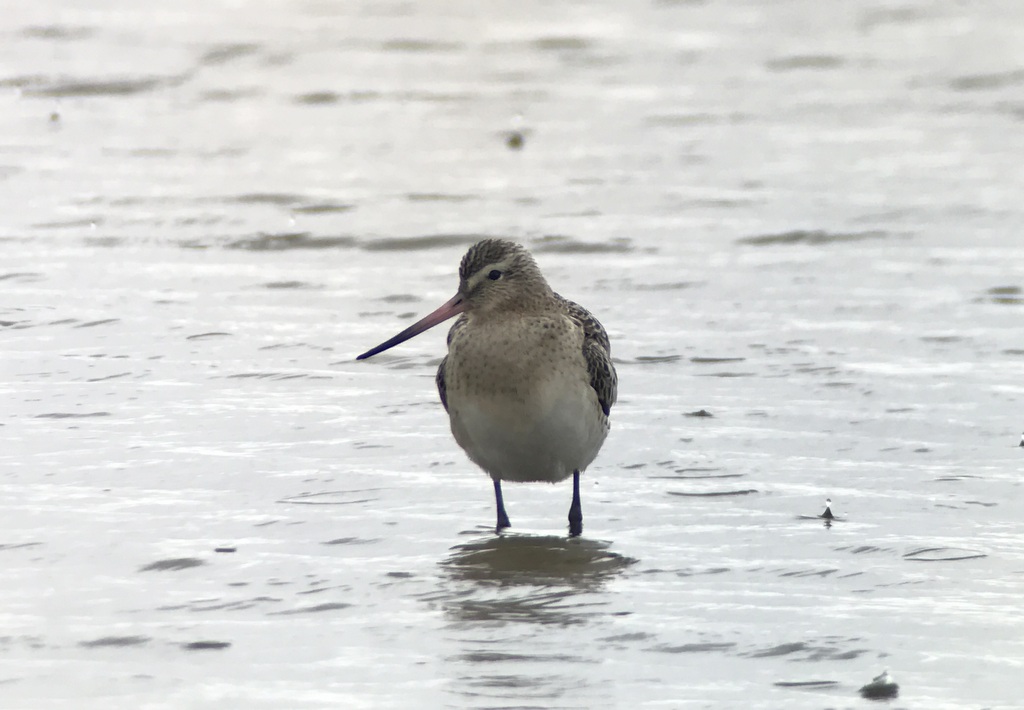
As the tide was rising out at the beach, a few more waders did drop in, but none stayed for long. First, a single Bar-tailed Godwit flew in and had a quick bathe, before flying off again. Then a small flock of Turnstone landed on the pile of bricks. They too had a quick bathe before heading off back towards the beach. A single Common Snipe appeared out of the reeds along the bank and fed in the edge of the water.
A Water Pipit had apparently been seen earlier, along the edge of the freshmarsh beyond the hide, in the low cut reeds, but it was not there when we arrived. We were almost about to leave when it flew across in front of the hide and landed down on the edge again. We had a good look at it through the scope, though it was hard to see at times in the vegetation. It is starting to moult into summer plumage, losing its black streaks below, though not yet especially pink on its breast.
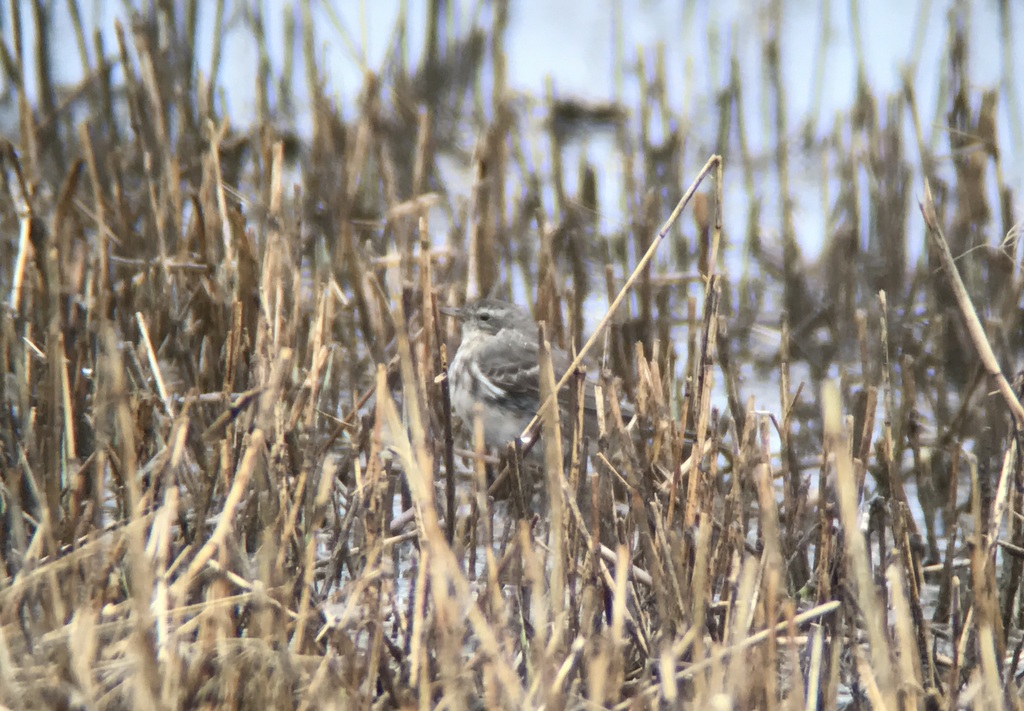
The rain at least eased a little, so we went round for a quick look at the Volunteer Marsh from the other side of Parrinder Hide. There were a few more Avocets on here – this is just about the only place they can feed at Titchwell at the moment. Two or three Grey Plover were out on the mud too and we found a single Knot half hidden in the vegetation.
It was now or never, so we decided to make a quick bid for the beach. On the other side of Volunteer Marsh there were a couple of Black-tailed Godwits with the Redshanks around the big muddy channel. The tidal Pools were full of water still and there was very little on there again apart from a few Shoveler.
Out on the beach, the tide was coming in. There were lots of gulls on the shore away to the east and a scattering of waders still feeding on the wetter areas of sand, mainly Oystercatcher and little flocks of Knot.
Looking out to sea, we quickly located the Long-tailed Ducks just offshore. There were eight of them, including a couple of smart drake with their long tails, one of them already moulting into breeding plumage. Further out, we could just make out several Red-breasted Mergansers in the mist. A Great Crested Grebe was a bit closer in and easier to see.
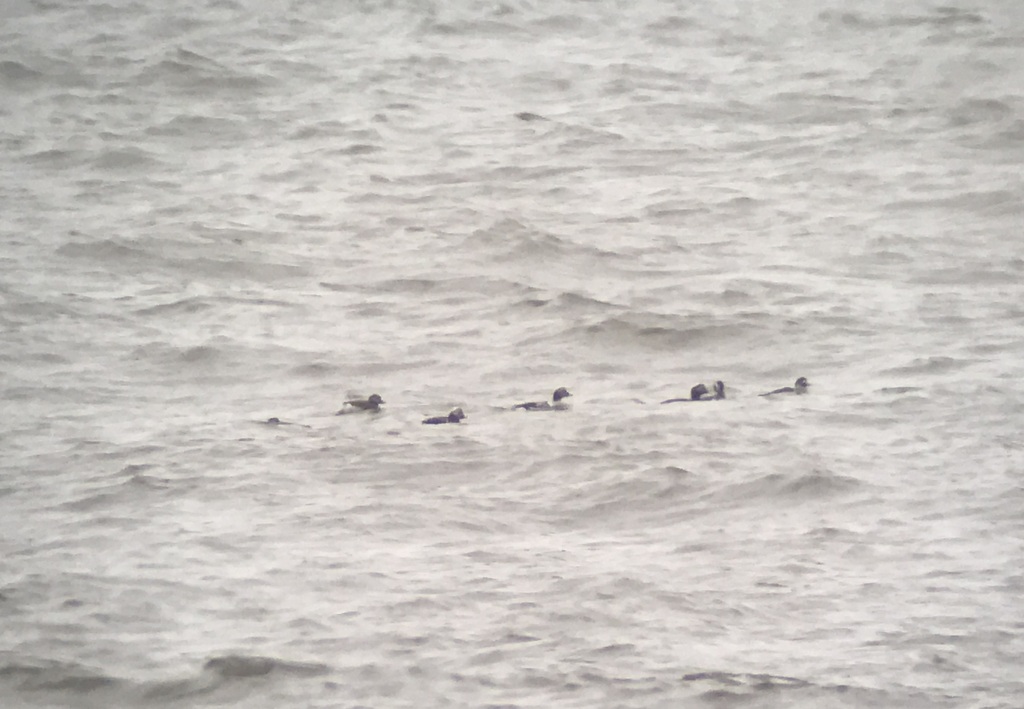
It was not a day to be spending any time out on the beach today, so we decided to head quickly back. Two Little Egrets on the saltmarsh were good to see, as this species appears to have been hit hard by the cold weather this winter. Back at the reedbed, the Bearded Tits were still feeding around the edge of the pools by the path.
We made a quick detour round via Meadow Trail. There was nothing on the pool in front of Fen Hide but there were a few more birds on Patsy’s Reedbed. Two Great Crested Grebes were asleep on the edge of the reeds, and there were a few Tufted Ducks and Common Pochard too.
As we got back to the Visitor Centre, we could hear Bramblings singing again in the trees, though its is more of a wheeze than a song. Scanning the branches, we eventually managed to find a smart male in the top of a thick hawthorn, before it flew off, and then a female feeding on the appeared nearby feeding on the opening leaf buds.
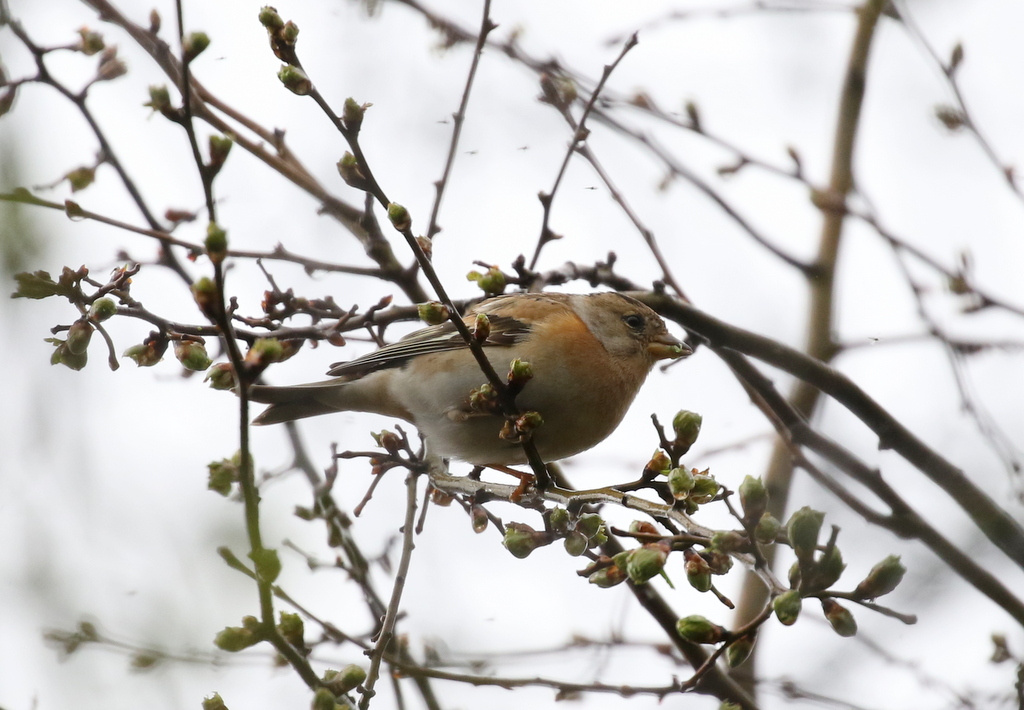
The rain was finally easing, and there was even a hint of brightness where the sun should have been. Unfortunately, just as it was time to finish. Hopefully it bodes well for tomorrow. Still, we had enjoyed a very successful day despite the weather. Now it was time to try to dry out!
















